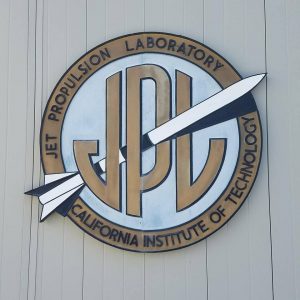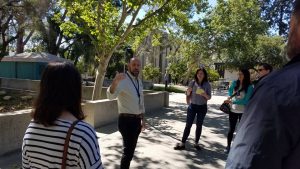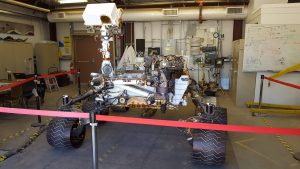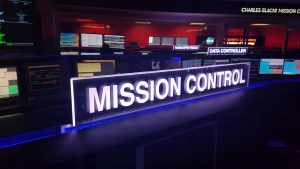
“The fact that we don’t know how planets are formed is really depressing.” That is Dr. Randii Wesson talking, and he is saying it with a big smile. He is referring to a debate about whether planets begin as gas and collect solids or whether it is the other way around. But he is really nodding to the never-ending supply of mysteries (some of them tantalizingly fundamental) that the Jet Propulsion Laboratory (JPL) exists to unlock.

Randii Wessen leads the tour
Last week, Dr. Wesson talked through several of the big questions: Was there ever life on Mars? Can dust be used to create massive mirrored surfaces in space? as he led a dozen film and television writers on a tour of the JPL campus. An engineer at JPL since 1984, Dr. Wesson is your ideal guide if you are a space exploration geek, even if your enthusiasm happens to outpace your grasp of the science. He is a dry-witted wrangler of esoteric ideas and has the kind of anecdotes from his time at JPL that make you wish you were packing a recorder and a stack of releases. (Naturally, the JPL/NASA politics, proposals, and personalities are as rich with dramatic potential as all of the actual exploration going on.)
Wesson and his colleague Rachel Zimmerman-Brachman, an expert on the Cassini-Huygens mission to Saturn, kicked off the tour with a stroll through the Visitor Center. It is a great overview of the lab’s many victories thus far, with models of everything from Explorer I—a satellite built and controlled by JPL in 1958—to Voyager, the interstellar probe launched in 1977 that is currently the farthest spacecraft from Earth. And of course, front and center, there is a model of Curiosity, the Mars rover that touched down in 2012. It is an exciting vehicle to see up close and the perfect segue to the next Rover-centric phase of the tour.
We followed Wesson to the heart of the campus, up to an observation deck overlooking a massive clean room where the next big idea will soon be constructed: the Mars 2020 rover. Set to launch in a few short years, the new rover will carry equipment that will collect and prep rocks and soil samples in search of bio signatures—possible signs of ancient life on Mars. The rover comes equipped with instruments that can provide on-the-spot high-resolution imaging and spectroscopy, but they will also be able to drill core samples and leave them behind to be collected by a later mission.
A little farther up the hill, we headed to another location key to rover creation: the Mars Yard. The opposite of a clean room, this little patch of dirt and rocks is used to put mock rovers through their paces, testing out tires and grips and getting a sense of the way the machine behaves on various types of terrain. It is out here that we met MAGGIE—the Mars Automated Giant Gizmo for Integrated Engineering. MAGGIE is Curiosity’s exact twin, so seeing her close up is the best way to check out all of the technology that landed on Mars 5 years back.

MAGGIE
Wesson had promised at the outset to toss in some off-the grid goodies, so after the Mars Yard, he took the group up to a few of the advanced concept labs to see what we could see. Luckily, along the way, we snagged an off-duty engineer who obliged us with a tour of his Starshade project. At first glimpse, the Starshade is a massive, gold-foil sunflower, complete with intricate petals. Its purpose is to shield deep space telescopes from glaring starlight, so that they can better see the details of exoplanets that would otherwise be blocked out. Should it successfully pass through the review stages ahead, it could become a key advancement toward the goal of locating other habitable planets. (Or, as its very sci-fi banner announces: “the search for other Earths.”)
We put our cameras away for the next lab to avoid leaking details about a few competition-ready projects under way inside, but got a glimpse of ATHLETE—the All-Terrain Hex-Limbed Extra-Terrestrial Explorer. It is a rover of a whole different order, equipped with six nimble legs that can work together to carry a small habitat (think lunar camping), or work independently to lift, drill, or grip cargo. ATHLETE is being developed as part of the Human-Robot Systems Project, which is one of several projects focused on developing new technology in support of human exploration.
After a spin through the current state of JPL’s earth science projects (in addition to space exploration, JPL also supports the Center for Climate Science), Wesson finished the tour in the “center of the universe,” also known as Mission Control. It is a cool, dark room limned with blue lights, which Wesson admits were added specifically to make the place look awesome, equipped with everything one needs to track dozens of deep space spacecrafts. On this Friday afternoon, it was manned by a few members of the Cassini team, looking over data coming in from the final phase of the probe’s trip to Saturn. Any day now, it will crash into the planet’s surface, and this is the room where the engineers and scientists at JPL will bid it a final farewell. It is a fittingly dramatic setting for some of the most exciting and inspirational turns in space exploration to date.







